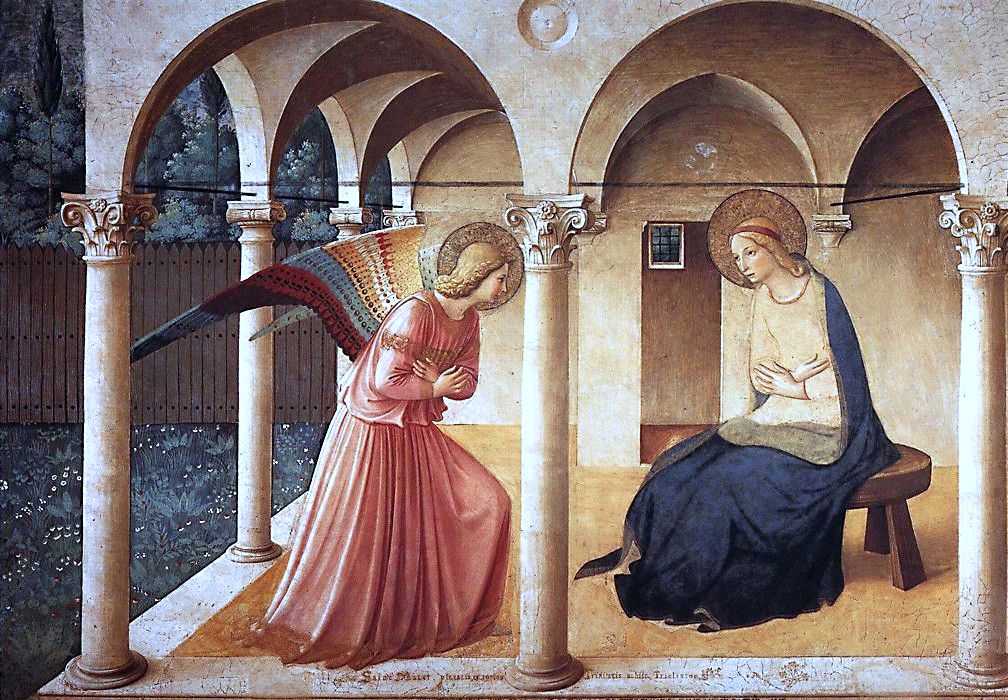
“The Annunciation” by Fra Angelico (circa 1395-1455), fresco, painted between 1438 and 1450, housed at the Museum of San Marco, Florence, Italy. CC 2.0/FLICKR VIA WIKIMEDIA
Spiritual Life
CONNIE ROSSINI: The Lord is with Mary – and us
May 20, 2021
The Hail Mary is one of the most familiar prayers to us as Catholics. But do we take the time to really think about what we are praying and why?
Since it is a vocal, memorized prayer, we easily say it thoughtlessly and carelessly. Studying the words of the prayer can enliven our whole Rosary, which in turn can lead us to deeper expressions of prayer. What does the Catechism teach about the Hail Mary?
The first words of the Hail Mary are taken from the archangel Gabriel’s words at the Annunciation. He greeted Mary, “Hail, full of grace, the Lord is with you!” (Lk 1:28). The Catechism says, “It is God himself who, through his angel as intermediary, greets Mary” (no. 2676). The word “angel” comes from the Greek for “messenger.” An angel does not speak his own words; he carries the word of God to others. At the Annunciation, the word that Gabriel brings is more than just a greeting. He is a herald of the living Word of God, the second Person of the Trinity.
Sent by the Father, Gabriel invites Mary to cooperate with the Holy Spirit in bringing the Word of God to life as a human being. His words, “the Lord is with you,” both state the truth – Mary lives in constant union with God – and prophesy the Incarnation. Mary will bring forth a Son, “‘and his name shall be called Emmanuel’ (which means, God with us)” (Mt 1:23). Mary in a sense represents all of God’s people, to whom God-made-Man will come.
Many commentators have noted that Gabriel does not say, “Hail, Mary,” but “Hail, full of grace.” It is as though “full of grace” were her name or title. This phrase, too, is both true and prophetic. Mary was conceived without original sin and she never committed a personal sin. She has never turned away from the grace of God. With her “yes” to the Incarnation, she will bear in her womb all grace in the Person of Jesus. By giving birth to him, she will become a mediatrix between God and mankind, making grace available to all those who follow her in consenting to God’s will. The Catechism says, “Mary is full of grace because the Lord is with her. The grace with which she is filled is the presence of him who is the source of all grace” (no. 2676).
The Catechism continues, “Mary, in whom the Lord himself has just made his dwelling, is the daughter of Zion in person, the ark of the covenant, the place where the glory of the Lord dwells. She is ‘the dwelling of God … with men’” (ibid.). In the Old Testament, God told Moses to build an ark, a sacred chest in which to keep the stone tablets with the Ten Commandments; Aaron’s staff, which had worked miracles; and some of the manna that fell in the wilderness. The ark rested in the holy of holies, the innermost room of the temple, where the high priest alone could go to plead for God to forgive the sins of the people.
The Israelites saw the ark as God’s throne, where the presence of God dwelled on earth. Mary is the ark of the New Testament. Jesus, who perfectly fulfills the law of Moses, who performs greater miracles than Aaron, and who is the “true bread from heaven” (Jn 6:32), resides in her. As (non-ministerial) priests of the New Covenant, we can go to Mary to find God’s mercy and grace.